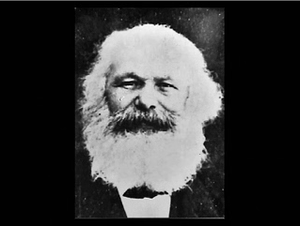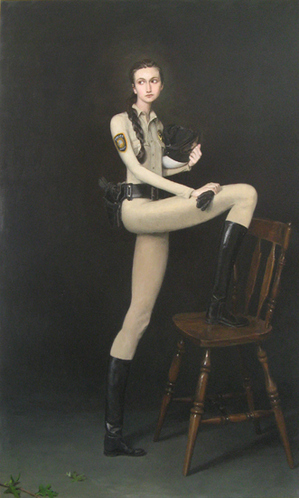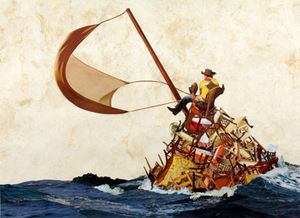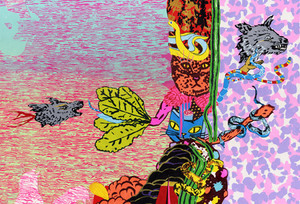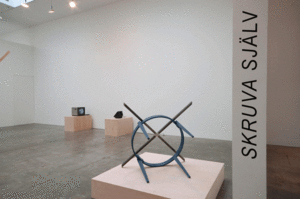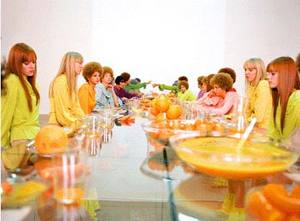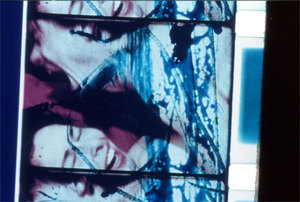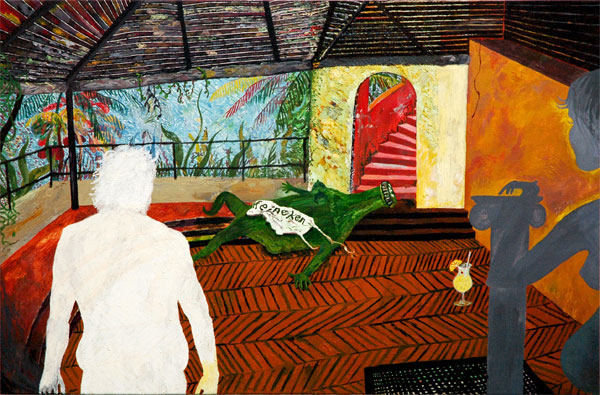This is an archive of the ArtCat Zine, 2007-2009. Please visit our new project, IDIOM.
November 2007

Visual AIDS Benefit Preview Party
6-8pm, 20 Novemeber 2007
James Cohan Gallery - 533 W. 26th St, New York NY
$75
Visual AIDS Benefit Sale
12-6pm, 21 November 2007
12-4pm, 22 November 2007
James Cohan Gallery - 533 W. 26th St, New York NY
FREE
Visual AIDS, New York's premier not-for-profit organization working to increase and support dialog between AIDS research and activism and the visual arts hosts its tenth annual Postcards from the Edge fund raiser preview party tonight at James Cohan Gallery in Chelsea. Tickets to the party are $75 and include a raffle ticket with a chance to win any single artwork of the more than 1000 offered for sale this weekend. The remainder of the postcard-sized artworks will be sold at $75 a piece starting on Saturday, World AIDS day, and continuing through Sunday. The benefit offers a unique opportunity for collectors to pick up small, affordable works while supporting this tremendous nonprofit. The proceeds from the preview party tonight will of course go directly and completely to Visual AIDS, and offer supporters of the organization a sneak peak at the postcards going on sale over the weekend. Each work offered over the weekend will be exhibited anonymously, and the identity of the artist will only be released upon the work's sale. The list of artists who have donated work, a cross-generational and impressive roster, is available on Visual AIDS's website.
Love & Hate
Online exhibition at TANK.TV
Nada Prlja, Nemanja Cvijanovic, Nikola Uzunovski,
Zaneta Vangeli, Vesna Milicevic, Olgica Dimitrovska,
Nemanja Cvijanovic, Skart.
October 2007 - November 2007
This month's edition of UK-based TANK.TV video exhibition platform features a group of Eastern European artists working in video and addressing the geopolitical realities of a now defunct Yugoslav state. The works on view are of an overwhelmingly sober mood, quite a few of them silent, explicitly emerging out of a cultural milieu in which the the spectacle of late capitalism has all but eclipsed much international interest in the complex systems of social- and power relations forming to fill the ideological voids in a number of failed socialist and communist national projects. While resonances of the wide-ranging encroachment of decrentralized systems of inequity may be perceived if we look at countries like Vietnam, gravely moving away from its hard-won socialist past towards a global-economy future (a move that is the primary subject of Jeffrey Skoller' new three-part video work The Promise of Happiness which premiered at 16beaver some weeks ago) there is still something distinct happening in Eastern Europe, a place where notions of identity are never fixed.
Since as early as the Italian Renaissance and the rise of a self-conscious Western European cultural identity, the people of the Balkans and Eastern Europe have been denied access to the abstracted cultural lineage of a proud Western Eurocentrism. Caught for many centuries between the imperial rule of a constantly shifting Ottoman Empire, only to be replaced later by subjugation or the threat thereof by Austro-Hungarian rule, Nazi rule, and later an expanding Russian communist superpower, the people of the the Yugoslav state and its bordering nations were neither firmly Occidental nor Oriental subjects, forming identities, instead, to centers of power on relational and often implicitly fleeting terms.
Thus Macedonian artist Nada Prlja, performs indecisively in her video WEST, where she can't decide whether she wants to face East or West. She eventually wipes the former mark from her countenance only to transform the sign into a black smear that is at once evocative of both a high-fashion make-up advertisement and a chilling marker of domestic violence. Croatian artist Nemanja Cvijanovic meanwhile presents a video animation of an older Marx silent and repeatedly shedding a nearly imperceptible tear. But is Marx bemoaning the rise of global capitalism or the fact that his critical work may now have more currency among academics than revolutionaries? Serbian artist Nikola Uzunovski aestheticizes television static in Snowfall, a distinctly socialist condition apparently, reflecting on a time when the now never-ending televised stream of commercial programming would stop at a "media curfew" (11pm in Socialist Yugoslavia). Finally, there is the work of Belgrade-based art collective Skart, who present documentation of an organized public choir singing, appropriating an older propagandistic political form used in Yugoslavia's earlier days to create images of national unity. The image resulting in the video Pesma izdradnje is one of a popular resistance to the oppressive powers at home and abroad by a young populace in waiting, unsympathetic to the political extremism steadily in the making for many years and trapped in a turn of the century Yugoslavia under closed borders and an economic and military siege from nations both local and distant.
Bring Me the Head of...
Serkan Özkaya
Freemans Restaurant - Rivington btwn. Bowery and Chrystie
October 27-November 20, 2007
This year's PERFORMA 07 performance art festival has been a windfall of offbeat events that test the limits of a medium that is inherently irreverent. One of the most peculiar of the lot was Serkan Özkaya's Bring Me The Head Of... at Freemans restaurant in the Lower East Side.
Working with Freemans chef Jean Adamson, Özkaya presented the U.S. premiere of his performance as part of the restaurant's weekday lunch menu. It was a piece curated by Performa's Defne Ayas — though I can only imagine what her role in this context would mean; did she pick the restaurant? The cynical side of me thinks the selection of Freemans' lunch time menu was as much a ploy to drive traffic to a locale otherwise deserted for the second meal of the day. Regardless, conceived as an artwork, half the "performance" of this dish is out of sight of the viewer, since it is assembled and prepared in the kitchen but still, one imagines or hopes, under the magical hand of an artist that was intimately involved in its original creation. I personally had fantasies of Özkaya adding the finishing touches to each plate before it exited the kitchen (perhaps I have seen Ratatouille too many times).
Now for my confession: I am a devout fan of Freemans and knew little if anything of Özkaya's work before this performance. I had seen his collaboration with the New York Times, but knew little else of the Istanbul-based artist. I arrived at the restaurant expecting a sumptuous feast, eager to try what was put on my plate and hoping my food allergies (nuts mostly) wouldn't interfere in my aesthetic experience. With only the name to go on, I imagined that Özkaya and Adamson had concocted some head-like dish composed of elements as attractive as they are delectable — a higher-order artisanal tofurkey I surmised. The title of the work made me think of Salome and her deadly, consuming desire for St. John the Baptist which eventually spelled his end. "This has got to be interesting," I anticipated.
Jansson Stegner
15 November - 22 December, 2007
Bellwether Gallery - 134 Tenth Ave, New York NY
The way in which an artist chooses to depict their subject usually says as much about a subject as the subject itself. Jansson Stegner’s recent exhibition at Bellwether is indicative of this statement. Stegner’s subjects, police officers, are portrayed in a mannerist style, lounging in ideal naturalistic settings.
That mannerism is one of the first notable features of this work, and its historical pedigree lends his paintings their conceptual heft. The sixteenth century mannerist period dovetails nicely with the current state of the art world in the midst of high American imperialism — the printing press revolutionized media, commerce was expanding on a global scale, and the changing religious environment led to political and cultural strife. Art was changing too; the classical canon was abandoned, and artists began to stress intentional distortions. Arguably, we face a similar situation today in which the modernist canon has been abandoned for post-modern deconstructions.
Obviously Stegner is not the first to revisit this form; the figure of John Currin hangs over this exhibition with an uncanny sense of déjà vu. Both Currin and Stegner appropriate the formal devices of mannerism to point to the decadent state of art and culture. Whereas Currin makes a more ambiguous gesture towards the lifestyles of a carefree and privileged bourgeois, Stegner is much more politically explicit, choosing the police as his subject. His figures — like that of the young woman in Let Your Loveliness Fade As It Will, who stands contrapposto tying her long blond hair in a pony tail — are tender, seductive portraits of a vulnerable power.
In his last solo exhibition at Mike Weiss Gallery, Stegner portrayed his subjects, also dressed in police uniforms, in a variety of violent and taboo situations, such as a reckless motorcycle accident and a casual woodland orgy. His brushwork had a charming awkwardness, depicting just enough information to direct the viewer towards the broad outlines but leaving them to fill in the gruesome details. Those paintings had a sense of urgency, a personal involvement with a disordered and complex state in which his figures struggled.
This show leaves behind that expressive brushwork and personal touch, and moves towards a more aloof statement. Stegner’s brush no longer seems to battle with his characters, but historicizes them with a sense of psychological detachment. Throughout the show, Stegner maintains a singular format, his hot cops lounge idyllically, alone, their gaze averted and introspective. These figures betray their humanity and our self-recognition. Looking at these pictures might feel like looking at a display case in the Museum of Natural History: the animal has been stilled in a pose that only mimics the life it once had.
Ladies Night at The Pawn Shop
with Julieta Aranda, Liz Linden, and Special Guests
7pm
e-flux - 55 ludlow street, New York NY
FREE
Gillian Laub at the NYPL
6:30pm
Mid-Manhattan Public Library - 455 Fifth Ave, New York NY
FREE
From the Specific to the General: The Publications of Seth Siegelaub
with Alexander Alberro, Christophe Cherix, Lawrence Weiner, Robert Barry, and Seth Siegelaub
6:30pm
MoMA - 11 West 53 Street, New York NY
$10
Tonight at 7pm, e-flux hosts Ladies Night at The Pawnshop, a discussion between artists Liz Linden and Julieta Aranda on ethical consumerism and strategies of reverse gentrification; hot topics, perhaps, for the holiday season in general or in the wake of this year's Buy Nothing Day in particular. There is a reminder of the latter anti-holiday on e-flux's website, meant as a counter to Black Friday (usually one of the 10 most active shopping days of the year in the US) and to function symbolically as a day to launch anti-capitalist protests and potentially send minor shockwaves through retail and other industries. Buy Nothing Day, although now largely supported and publicized through Kalle Lasn's AdBusters journal, was initially started in 1992 by Vancouver-based illustrator and artist Ted Dave. That e-flux should mention Buy Nothing Day is nothing short of wry, self-aware irony, considering the downtown location has been converted into an aestheticized Pawnshop-style depot of commercial art, and is still buying and pawning work by artists.
Meanwhile in mid-town at the New York Public Library photographer Gillian Laub will present and talk about her recently published book of photographs Testimony, a suite of portraits taken during the photographer's five year travels in Isreal, Palestine, and the more contested areas between the two. Pictures of Isreali Jews, Isreali Arabs, displaced Lebenese families, and Palestinians constitute the book, along with transcripts of written "testimonials" given by Laub's subjects. The artist will be speaking about her work and it's relation to the 40 anniversary of the Arab-Isreali Six-day War, a conflict highly formative in the current disputes over control of the Gaza Strip, West Bank, and the Golan Heights.
At MoMA tonight, contemporary art historian and critic Alexander Alberro talks to museum curator Christophe Cherix, artists Lawrence Weiner and Robert Barry, and former gallerist and publisher Seth Siegelaub. The discussion will be on Siegelaub's historic contributions establishing exhibition platforms for conceptual art since the 1960s both in traditional gallery spaces and in publishing projects, with a focus on the latter. When Siegelaub operated a New York gallery in the mid 60s, he was a steadfast supporter of conceptual work, going so far as to provide couches for gallery patrons to sit on in order to have more time to contemplate the work on view.
Artcal Zine will be withholding new content today and tomorrow, in observance of the national holiday. We will begin posting again after the weekend.
Don Quixote and Other Stories
Javier Piñón
15 November - 22 December 2007
ZieherSmith - 531 W. 25, New York NY
I like collage. It's fast and economical, and paradoxical. It's about making things up by not making anything up. And, like Javier Piñón, I am from the southwest. So I grew up on all this Marlboro Man imagery and the rodeo, as well as a heavy dose of Catholicism. I can't go on without admitting that Piñón's work soothes me — it confirms and upholds some things I already know to be true. It's easier to write complete and rigorous thoughts when you're pushing at something new.
But Don Quixote And Other Stories is not about novelty. In fact, in some ways you've seen this show before. It's all smallish and tastefully framed. It's doing that surrealist collage thing that Hannah Höch explored thoroughly about 80 years ago and is now downright academic. And it's steeped in all sorts of things you may or may not already know — it's about references. It helps if you've already experienced the visual language of the actual southwest: its sweet and desperate patron saint candles and lonely roadsides, and the technicolor landscapes of old Arizona Highways and Sunset magazines. It is helpful to walk into this show knowing your mythology, your western films, your pop culture. It also helps if you've read Joseph Campbell.
Early Worm Gets the Bird
Brian Chippendale, Jungil Hong, and Kevin Hooyman
16 November - 30 December 2007
Cinders Gallery - 103 Havemeyer St., Brooklyn NY
Skinny punk rockers don't just inhabit a solipsistic world of their own personal minds. Theirs is a closed world, sure, but one that triggers the common curiosity and sends it to wander through the landscape of visual bombardments that comprise their persona. If, after all, behind the facade, there lies a phantasmagorical place of monsters, creatures, and colorful incarnations of fleshy beings that stem directly from the well-earned street cred of any respectable rock star hipster, then art and life have just converged in the most auspicious of circumstances. Cinders, the small and clever gallery in Williamsburg that consistently boasts art and cool that is as visually entertaining as its spectators and openings parties, brings us an exhibition titled "Early Worm Gets the Bird" with new work by Brian Chippendale, Jung Hong, and Kevin Hooyman. The artists share their infectious fantasies and deep-rooted obsessions of all the creatures, characters and fantastical places that embody the cornucopia of colors and shapes in the exhibition. The work is about ingesting, expelling, conceding to all things scary and insidious while intimating all the potential for new life through regeneration.
Brian Chippendale, whose collages have the neon putridness of a Crayola box, reminds us that colors range indefinitely while their actual nature is toxic and plastic, much like the subject matter of his loud compositions. Chippendale, who drums with his bassist and second half of Lightning Bolt, is no stranger to noise. Loud, pulsating rhythms prevail through amped up antics of life-affirming passion that let you lose control again. Such is his music and such is his art because a true artist conflates and converges while upholding the hardcore credo of his essence with utter honesty. Jung Hong, who shares a warehouse with Chippendale in Providence, RI, brings her lust for life in the most literal sense onto the visual canvas. Each construction encompasses a terrarium that hosts a living plant as it grows and battles for survival amidst the maelstrom of hellish obstacles. Apparently, she has over two hundred plants at home, bringing life to her industrial home-scape and to each art work she undertakes. Hooyman's all-over drawings reflect the obsessive hand of a deft precision that makes each work stunningly worthy of some serious inspection. Incidentally, he lives in the town of Climax, NY, a happenstance that adds such poignancy to an otherwise overlooked convention.
Cinders, whose mostly affordable prints, t-shirts, zines, pins, and imperative "Slingshot" organizers keep its simple concept afloat never disappoints. Each group show is as energetic and PBR-filled as the previous, and as colorful and imaginative as the subsequent will probably be. This year, the gang has the pleasure to participate in the Aqua Fair in Miami during the weekend of Miami Basel. Although I'll still be stuck in somber Brooklyn, jealous as hell of my friends who'll be sipping their roadies on the beach, I'm thoroughly excited for Cinders to bring a chunk of our Brooklyn to the sunny art world overload of Miami. Until they go, you can still check out this show at the gallery.
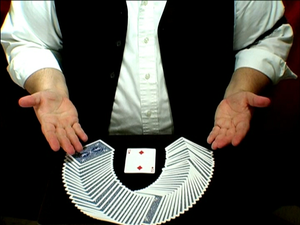
Courtesy of the artist and Gavlak Projects, West Palm Beach
The Visitors
Jose Alvarez
1 November - 22 December 2007
The Kitchen - 512 W. 19th St., New York NY
Lenore Malen
6 September - 13 October 2007
CUE Art Foundation - 511 W. 25th St., New York NY
In her 2003 essay, "Cults and Cosmic Consciousness," critic Camille Paglia likens our contemporary sociopolitical climate to the upheaval experienced in both late Hellenistic and imperial Roman times. Paglia reckons that the proliferation of cults, a phenomenon common to all three eras, is symptomatic "of cultural fracturing in cosmopolitan periods of rapid expansion and mobility." Rather than envisioning 1960s-style alternatives - however flawed - to the status quo (a la Timothy Leary's "turn on, tune in, and drop out"), the disillusioned among us today turn on and tune out by embracing the culture of distraction. But celebrity worship, cinematic spectacle, and hyper consumerism fail to satisfy deep spiritual needs and signs of our want are abundant in popular culture: television programs feature paranormal investigators, mediums, and psychics; horoscopes are a staple of newspapers; religious fundamentalism is experiencing significant surges in popularity.
Yet western academics and arbiters of high culture have for the last thirty years dismissed projects that esteem religiosity or the occult. Adolescent and iconoclastic efforts critiquing, attacking or lampooning religion were accepted, but devotional or faith-oriented works were rarely printed or exhibited by mainstream publishers or galleries. Fortunately, we are beginning to jettison the self-conscious rhetoric and cynicism of late 20th century philosophy and critical thinking. As a result, contemporary artists address our spiritual void more honestly and, in doing so, they often draw on the social experiments and ideologies of the 1960s and 70s. Psychedelic painting is appearing in galleries, as is an affection for pagan or pantheistic metaphysics and ritual magic, cornerstones of cultism.
Cultism is a natural outgrowth of human society. It can be denied, but never abolished. Indeed, though mainstream media outlets and academic institutions continue to frown on articles or expressions of deep faith, most of the world's population, ours included, identifies as "religious." The truly global citizen must relearn (or at least learn to respect) the value of sacred symbols and rites. But can we also learn to accept spiritual plurality? Is cultic belief fundamentally anathema to pluralism? Are we sophisticated enough to discern between "real" spirituality and the quick con or, more seriously, demagoguery? These questions are central to the projects of two artists about whom more should be known, Jose Alvarez and Lenore Malen.
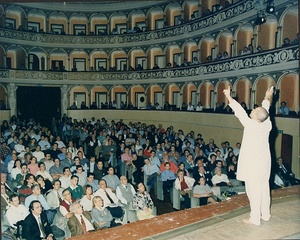
Courtesy of the artist and Gavlak Projects, West Palm Beach
In his current solo exhibition, The Visitors, at The Kitchen, Alvarez includes some documentation of the Carlos project, but most of the work on display is more recent. Two videos call attention to the illusion sold credulous audiences by skillful magicians and mediums. One of these, The Guessing Game, is a montage of television appearances by "survival evidence medium," James Van Praagh. Van Praagh uses time-honored tricks of the trade to appeal to his subject's desire to "communicate" with a lost loved one. Most often, he supplies a generality, couched in ambiguous language, and the subject, determined to believe, faithfully fills in the details. To illustrate the extent of the mediums' chicanery, Alvarez edits Guessing Game in a manner similar to that which filmmaker Robert Greenwald used for his documentary, Outfoxed, a rapid cut, propagandistic style that manipulates the viewer in much the same way the artists' respective targets manipulate their subject or audience.
As an alternative supplement to the dozens of openings this week in commercial galleries around the city, the twice a year opportunity to visit two important MFA programs happens tonight — at Hunter College tonight (6-10pm Friday 16 November W. 41 street, 450, b/w 9 & 10 avenue) and Columbia University on Saturday (2-430pm 17 November 632 W 125th st, 4-6pm at 612 W 115th st, 6-8pm at 310 Dodge Hall on 2960 Broadway at W. 116th).
The International Studio and Curatorial Program of New York opens its doors as well this weekend, giving art spectators a chance to visit the studios of some 31 international artists working across media and currently completing their residencies at the ISCP. (Opening Recetion 7-9pm Friday 16 November, 12-6pm Saturday 17 November, 12-6pm Sunday 18 November, 2-8pm Monday 19 November at the ISCP, 323 WEST 39th ST, 6th, 7th, and 8th floors)
This weekend offers a chance to see Tony Conrad's The Flicker (1966), one of the foundational works of American structural film. Other 70s works by Conrad will be presented, including Straight and Narrow (1970), a black and white film with hallucinatory color inducing effects, and Film Feedback, an experiment in real-time film processing and re-photography. The three works comprise a suite of historic minimal, and quite challenging, American avant-garde cinema. (6pm Sunday 18 November 32 2nd Ave at E. 2nd St., $8).
Performance artist Karen Finley gives a tour of Nation Building, her new show of drawings, installation, and video works currently on view at Alexander Gray Associates in Chelsea this Saturday. Finley's show, among other things, explores an interesting set of imagined Freudian underpinning to the subconcious lives of the executive policy makers. (4pm Saturday 17 November, 526 W 26 St #1019)
We recently relaunched ArtCal with a new design and this zine as the flagship site for the Culture Pundits advertising network, and we're seeking input from our readers. Please fill out our short survey. We thank you for your time in answering the survey, and helping us make ArtCal a better resource.
We will share the highlights of the survey with our readers in a few weeks.
Beat Meat Table Eat
Bozidar Brazda
Bortolami Gallery - 510 W. 25th St, New York NY
25 October - 24 November 2007
In Meat Beat Table Eat Canadian artist Bozidar Brazda continues to expand the crude visual vocabulary he has been developing over the course of his solo exhibitions and curatorial projects. Using appropriation techniques, readymades, repetition, and text, Brazda quotes culture high and low to create immersive proto-narrative installations with very economic means, resisting the temptation to engage audiences with overly worked or crafty objects — this latter point perhaps a real feat in 2007. Brazda's work is challenging, and the rewards for scrutinizing observers are mixed. What's certain is that with each new exhibition the artist remains in dialog with himself — albeit this dialog may be more witty banter than any sort of serious interrogation. Take his obsession with wordplay, a clear homage to Bruce Nauman in several cases as critic Brian Sholis pointed out in Artforum last year. The “Beat” of the show's title could be the a reference to “The Beat,” a show of short, percussive looping videos Brazda curated in 2006. The masturbatory suggestion in “Meat” and “Beat” signals the artist's self-involvement and autobiographical mode, while "Meat" and "Eat" recall his last New York solo show, at the now defunct Haswellediger & Co., where he installed wall texts that played on these words. This sort of collection and noncommittal engagement with language carries over to the free multiple Brazda distributes at the show (something he has done in the past as well) taking form this time around as a "zine" on newsprint titled MOGENSEN — the name of both Danish pre-modernist furniture designer Borg Mogensen and minor Danish punk rocker Niels Mogensen.
The exhibition itself borrows several forms from the artist's previous work. The gallery is filled with a set of unmodified round tables that reveal their origin by way of their titles — one of which hangs inverted from the ceiling, wrapped with industrial chain in a way that the press release likens to a slab of meat, another slightly deconstracted and leaning against crossed metal beams — a small collection of Scandinavian crackers and other food products, two large vinyl wall texts, a chair with a stack of MOGENSEN for distribution, a short looping video, and a tailored suit made of clear plastic. The entire exhibition has a sort of stale, downtrodden “Eastern Bloc” feeling to it, and if one is at all familiar with the artist's previous work and the bits of autobiography Brazda lets trickle down to viewers, such a conclusion becomes irresistible. Nothing is glossy or fresh, everything from the design of the objects on display to the visual forms of the deconstructed table feels expired, slightly outmoded.
Simply reading about it on the Internet doesn't exactly communicate the feeling one gets when walking past the site of the new New Museum, located on the corner of Bowery and Prince and conveniently on my way as I traveled downtown to see the new Aïda Ruiolva video at Salon 94 Freemans. The museum is at this point swarming with activity as it prepares for debut exhibit Unmonumental, a curious show of mostly senior and mid-career artists delineated by a narrow set of media distinctions. Perhaps the feeling related shouldn't be so spectacular when taken in context to the largely complete process of gentrification on the Lower East Side, but something still feels particularly unique when seeing the vanguard institution and the much lauded architectural work of Sejima and Nishizawa tower over the neighboring buildings, or the smartly dressed art admins photographing the building from outside as a small throng of older Bowery bums linger just 100 or so feet off. The newly commissioned artwork by Ugo Rondinone set to adorn the front of the museum for the opening will surely add to the spectacle, as described on Curbed.
Photography, Performance, and Contemporary Art
7pm Wednesday 14 November 2007
The New School Auditorium - 66 W 12th St
Free Admission
This Wednesday The New School hosts a panel discussion featuring artists Marina Abramović, Vanessa Beecroft, and Babette Mangolte, moderated by Performa Director RoseLee Goldberg. Photography, Performance, and Contemporary Art will explore the evolving relationship of photography and performance art. Surveying new genres in contemporary practice of the last century, much of our experience of such temporal work has been mediated through photography and video; that is, a lot of what's left to be surveyed are ugly, grainy, and challenging trace documents. All of this changes significantly, of course, with the professionalization of contemporary art and the implicit expectations of strong visual documentation constructed to outlast the performance itself. These documents not only project the artist's presence across time and space but also constitute the afterlife of the immaterial work and the career trajectory of the artist, acting as a mobile, representative token of the best qualities of the work, and communicating its importance to the arbiters of cultural production: collectors, grant makers, critics, and art historians, not to mention generations of younger artists acting in sympathy or agitation to the past work.
Compare the six-figure photographs produced as peripheral material to Matthew Barney's performance and filmmaking enterprises to the relatively casual documentation of performances by Barney's Shamanic forebear Joseph Bueys. The tremendous production costs of Barney's film works are thus offset by this very salable auxiliary material, but collectors likewise demand a certain primacy status to this peripheral work which is expressed in glossy production values. Thus the photos of Barney in character become testaments not to the larger project, but art works on their own.
We might also compare the signature 70s work by panelist Marina Abramović who made a name for herself working outside her geographic bracket and producing a strong body of International style body-performance work — often captured casually in photos and grainy video. Abramović recently reinvested herself in her own national, or perhaps pre-national, background with a new film and suite of photographs entitled Balkan Erotic Epic. Epic... is comparatively a Hollywood production by the old photo-doc standards complete with gorgeous cinematography and professional photographic production.
The question of production values and the visual forms in art performance could consequently be serious issues for younger artists pursing this type of work. Whether or not Vanessa Beecroft's spectacular performance photos are any less conceptually invested than if they had been shot from-the-hip could well be a moot point. To assume a less critical stance, we could well argue for an advanced conceptual practice that has emerged from the austerely documented 70s work; the more developed documentation procedures involved being the natural evolution of an art both bracketed by a moment in space and time and functioning in parallel with a trace-producing activity.
Christopher Reiger pens short reviews of Kristin Lucas' show at Postmasters, up through 24 November and Catherine Ulitsky at 511 Gallery up through 1 December. Excerpt from the former follows:
Postmasters: Kristin Lucas' most recent solo exhibition at Postmasters, "If Then Else End It," is divided into two parts. Occupying the main gallery space are three forgettable light box portraits and a dual-channel video installation entitled, "Whatever Your Mind Can Conceive." The video is projected onto billboard-like panels, and the wood grain grants Lucas' desert setting an impressionistic cast that complements the subdued, if uncertain tone of the work. Were the light boxes and video the sum of the exhibition, I'd have little more to write, but the work in Postmasters' back gallery is exceptional.Earlier this year, Lucas decided that she should "refresh" herself in a manner equivalent to a web page. She applied for a legally binding name change, trading Kristin Sue Lucas for...Kristin Sue Lucas. The same, but new. The cardinal work in the back gallery is a framed record of Lucas' application process, during which she made a case for the unorthodox change to a baffled, but surprisingly accommodating judge. Her remarks are sincere and unabashedly romantic.
To read the rest of the review, please click through to Hungry Hyaena.
Tom Moody starts a rowdy discussion about Diana Kingsley's recently removed photograph, Blue Ribbon, 2005 at 55 5th Avenue in NYC (at 13th Street). The photograph pictures the torso of a sweatered large breasted woman opposite a winning floral arrangement and was taken down due to a complaint that the work was insensitive to those visiting a neighboring mammogramy office. Moody takes the position that the complaint stifles expression where as the guardian's Ana Finel Honigman believes the work was inappropriately placed. I suppose those who are facing the possibility of losing their breasts might not want to see a picture of someone who presumably will be keeping theirs for some time, but it's hard to imagine a more tame photograph than this. I want to be sensitive, but these are the kinds of complaints that lead to the exclusive display of tepid landscape painting. Also see artinfo for a brief summation of the story.
This weeks Impressionist and Modern auction sales started out tame at Christies, who faired reasonably given a slumping economy, and led to a rather disasterous evening at Sothebys. That auction totaled 269.7 million, falling significantly below their presale low estimate of 355.6 million. Apparently the most disappointing moment of the auction came early on, when The Fields, a Van Gogh painting estimated to sell for as much as 35 million, drew not a single bidder. Sotheby's stock responded yesterday by plummeting 14.23 percent. Culturegrrl writes up a storm on this subject here, here, and here.
Tyler Green writes that while Dave Hickey is probably the most admired art writer of the moment, Laurence Weschler could stand to see a little more attention. I couldn't agree more. His book, Seeing is Forgetting, a biography of Robert Irwin is a must read for any artist. I might also advise artists to read Hickey with a few more grains of salt than many do. There are far too many hipster artists overly concerned with beauty and the whims of pop culture, all of whom have read Air Guitar and treat it as though it were the bible.
Paul Schmelzer interviews communications scholar Bob McChesney about the FCC ownership vote and net neutrality. If there was any question that the FCC has been acting rather shadily, McChesney clears this up in the except below,
Kevin Martin has reopened a review of its media ownership rules, as it’s required to by law. And he agreed, and the FCC agreed after the last time the rules were thrown out in the court system that to make sure it’ll past legal must this time they would hold at least six public hearings on what people think of these rule changes. The last one is coming on November 9 in Seattle. Chairman Martin of the FCC is making it clear that he is determined to change the rules – he’s been public about this – as quickly as possible, as dramatically as possible, and really has no concern whatsoever with following the spirit of the process where the public hearings hold any value. He’s given in almost every case minimum possible notice to the community that’d they’d be having hearings. The last two, literally a week's notice. And these are supposed to be hearings to solicit public opinion from across the board. They’ve tried to put them during daylight hours when working people can’t get away from work. And he’s made a mockery of the process.
To read the full interview click here.
Jeffrey Skoller
7pm Friday 11 November 2007
16beaver Group - 16 Beaver St., 4th floor, New York NY
FREE
Filmmaker, scholar, and critic Jeffrey Skoller will present The Promise of Happiness, the first in a new three-part work on video, tomorrow night at 16beaver. The work is a video essay on the revolutionary struggles in 20th century Vietnam. Tapping into the rich historical documents of a "cinema of revolution" — film artifacts of the the utopian aims of radical social transformation — Skoller examines the history of both these films and the supporting (or opposing) social configurations, with a strong look towards the future. "What meanings do we make of such imagery in the present, and of what use can be made of them, as they, along with the viewer, travel through time from a past historical moment to the present?" the press release asks. Mixing historical and contemporary footage, Skoller's work evokes the socialist struggles for social justice and cultural freedom and offers a chance to look at how those desires and aspirations have been woven into, transfigured, distorted, or otherwise, present-day society. In 2006 the filmmaker published Shadows, Specters, Shards: Making History in Avant-Garde Film (University of Minnesota Press) an art historical text in which he examined the capacities for film art to engage with historical issues. Continuing in the tradition of many of the filmmakers on which he has written about critically — Ernie Gehr, Jean-Luc Godard, Daniel Eisenberg, Abigail Child, Ken Jacobs, and others — Skoller's work functions both as a melange of historic documents and an experimental documentary look at Vietnam's present social conditions.
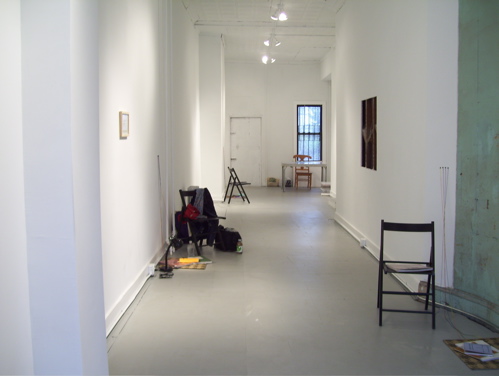
Courtesy of the Pocket Utopia Blog.
A Lawrence Weiner Salon
2 November - 25 November, 2007
Pocket Utopia - 1037 Flushing Avenue, Brooklyn NY
In his 'Notes on & About Art,' from 1995, Lawrence Weiner insists
ART IS NOT A METAPHOR UPON THE RELATIONSHIPS OF HUMAN BEINGS TO OBJECTS & OBJECTS TO OBJECTS IN RELATION TO HUMAN BEINGS BUT A REPRESENTATION OF AN EMPIRCAL EXISTING FACT …IF AND WHEN A PRESENTATIONAL SITUATION CANNOT ACCOMMODATE BY VIRTUE OF SELF-PROTECTION (CONFLICT OF BASIC IDEOLOGIES) A WORK OF ART IT (THE WORK OF ART) THEN MUST ERECT A STRUCTURE CAPABLE OF SUPPORTING ITSELF (THE WORK OF ART)
BUT WHATSOEVER SUPPORT IS FOUND CAPABLE BECOMES IN EFFECT LEGITIMIZED PERHAPS THE DIALECTIC CONCLUDES AS THE SYSTEM OF SUPPORT CHANGES
I would like to nominate the Lawrence Weiner Salon currently open at Pocket Utopia as the arrival of just such a self-supporting structure, with all attendant implications, but first, the details.
Pocket Utopia is a self-described 'away-from center, off-center, exhibition salon and social space run by artist Austin Thomas.' In setting up the Weiner salon, Thomas has carefully attended to the implications of the interaction between purpose and Weiner's work, to delightful effect. Thus the three main components of the show; 'a reading room, a re-creation, and a text piece,' can be seen as reflecting the social space, the salon, and the exhibition, respectively. All three are worth the trip, in and of themselves. The text piece, 'ART IS NOT A GAME IT HAS NO RULES' remains superlative at capturing Wiener's unique combination of playful beauty and intense seriousness, while the reading room has been dutifully stocked with much of Weiner's textual output, including his own book works, interviews, and collaborations with other artists. One could do far worse on a lazy Sunday than to spend it flipping through these volumes, chatting with the intelligent, amicable Thomas, and enjoying a coffee from the local bodega. It was certainly the highlight of my week.
Remains to Be Seen: New & Restored Films & Videos of Carolee Schnemann
6:30pm 7 November 2007
EAI - 535 West 22nd Street, 5th Fl, New York NY
FREE
Public Art Fund Talks: Stan Douglas
6:30pm 7 November 2007
The New School, John Tishman Auditorium - 66 West 12th Street, New York NY
$5
Tomorrow night at EAI in Chelsea, Carolee Schneemann presents some of her newly restored films and videos spanning a 40 year body of media work. Schneemann will be present introduce each work and answer audience questions. Schneemann's work often takes the form of body performance, popular and internationalized in the 60s and 70s, and takes on particularly political direction, distinguishing her from certain a number of her contemporaries working along similar lines. The presentation of her work is done in conjunction with Anthology Film Archives which will be presenting new film prints of several of Schneemann's works on 15-17 November 2007.
Video artist and photographer Stan Douglas also be giving a talk tomorrow at the New School as part of Public Art Fund Talks program. Douglas often makes narrative works and adaptations of films exploring contemporary cultural and political configurations, mixing high production values with sometime experimental editing techniques and deep seated cultural and historic references.
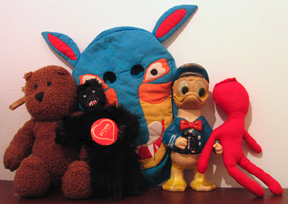
THE GUY DEBORD SHOW
5 November - 30 November, 2007
11:30pm weeknights
Live webcast and contemporaneous gallery exhibition
Today marks the start of the Guy Debord Show — a month long collective webcast and parallel gallery exhibition organized by artist Trong G. Nguyen in honor of the titular referent. Judging from the press release and the short summary of historic context, at least one of the dispersed exhibition's goals seems to be the reintroduction of the radical theorist's work via the very non-material in which he was so interested.
The first webcast, Berlin House Climbing Club by artists Tómas Lemarquis and Chris Filippini, happens tonight at 11:30. It's documentation of a collective, absurdist art-party that poses a "performance" challenge to participants, the press image of which shows a performer scaling the inside of an apartment in a blue sweater and Beuys-like felt hat. Tomorrow's broadcast will feature Death of the Artist from Eh-team's Masterpiece Television, one in a series of video spots designed to introduce contemporary critical, aesthetic, and theoretical hot topics to children through the use of narrative puppet theatre. The programming appears to be quite uneven, mixing a number of interesting art projects with only vaguely related events and musical performances, the complete schedule of which is available on NGC's website.
Although I haven't yet seen the show at CANADA gallery quite a few of my friends have been talking about, I did stumble upon James Wagner's fantastic documentation of a few of the new Michael Williams paintings hanging there, as well as some of his own thoughtful words on the show. I do plan on going to see the work in person, and based on hearsay and a few jpegs, would recommend it to anyone in the geographic proximity. James does a great job in his photos communicating the artist's expressive and involved use of color, his considered manipulation of perspective, and some of the neo-surrealist figures and content of the paintings.
In the context of having just read most of October's Art of Production survey in Artforum, and Phillip Tinari's lengthy piece on the Dafen Oil Painting Village in the Guangdong province of southern China, I came upon the following link on popular artblog vvork documenting a conceptual project by an anonymous Dutch artist. Just Another Painting is a blog that presents the purportedly real correspondence of an artist attempting to coordinate the remote overseas fabrication of a painting exclusively via electronic communication. The words and images exchanged are spare, and in effect demystify the art-making process. The painting being fabricated itself is constructed via a seemingly half-baked process of collage: the artist selects charged images and pieces them together haphazardly, his vision clearly inspired by fantasy art and an absurdist Internet montage aesthetic.
In Performa related announcements this weekend, Isreali performance and video provocateur Tamy Ben-Tor performs uptown at Salon94 on 3 November through 6 November, each time at 6pm. Email info at salon94 dot com to RSVP for the free performance. Writing of her own work, Tamy Ben-Tor is quoted on Performa's website as stating "it is not a specific individual which I portray, it is a mimicking of public opinion, of cultural phenomena." She has created work in the past exploring various facets of contemporary Jewish and Western political and cultural paradigms, and has put her formal training as an actor to excellent use with her convincing and arresting presence.
ZINE
HOME
TIPS / COMMENTS
CATEGORIES
CONTRIBUTORS
- Greg Afinogenov
- B. Blagojevic
- Adda Birnir
- Susannah Edelbaum
- Julie Fishkin
- Paddy Johnson
- Jessica Loudis
- Christopher Reiger
- Andrew Robinson
- Peter J. Russo
- Blythe Sheldon
- S.C.Squibb
- Hrag Vartanian

